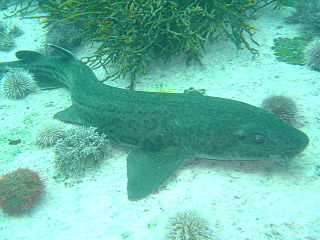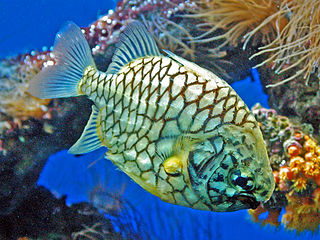
The oilbird, locally known as the guácharo, is a bird species found in the northern areas of South America including the Caribbean island of Trinidad. It is the only species in the genus Steatornis, the family Steatornithidae, and the order Steatornithiformes. Nesting in colonies in caves, oilbirds are nocturnal feeders on the fruits of the oil palm and tropical laurels. They are the only nocturnal flying fruit-eating birds in the world. They forage at night, with specially adapted eyesight. However, they navigate by echolocation in the same way as bats, one of the few birds to do so. They produce a high-pitched clicking sound of around 2 kHz that is audible to humans.

Anomalopidae are a family of fish distinguished by bioluminescent organs located underneath their eyes, for which they are named. These light organs contain luminous bacteria and can be "shut off" by the fish using either a dark lid or by being drawn into a pouch. They are used to communicate, attract prey, and evade predators.

The Beryciformes are a poorly-understood order of carnivorous ray-finned fishes consisting of 7 families, 30 genera, and 161 species. They feed on small fish and invertebrates. Beyond this, little is known about the biology of most member species because of their nocturnal habits and deepwater habitats. All beryciform species are marine and most live in tropical to temperate, deepwater environments. Most live on the continental shelf and continental slope, with some species being found as deep as 2,000 m (6,600 ft). Some species move closer to the surface at night, while others live entirely in shallow water and are nocturnal, hiding in rock crevices and caves during the day. Several species are mesopelagic and bathypelagic. Beryciformes' bodies are deep and mildly compressed, typically with large eyes that help them see in darker waters. Colors range from red to yellow and brown to black, and sizes range from 8–61 cm (3.1–24.0 in). Member genera include the alfonsinos, squirrelfishes, flashlight fishes, fangtooth fishes, spinyfins, pineconefishes, redfishes, roughies, and slimeheads. A number of member species are caught commercially, including the alfonsino, the splendid alfonsino, and the orange roughy, the latter being much more economically important. Some species have bioluminescent bacteria contained in pockets of skin or in light organs near the eyes, including the anomalopids and monocentrids.

Ophichthidae is a family of fish in the order Anguilliformes, commonly known as the snake eels. The term "Ophichthidae" comes from Greek ophis ("serpent") and ichthys ("fish"). Snake eels are also burrowing eels. They are named for their physical appearance, as they have long, cylindrical, snake-like bodies. This family is found worldwide in tropical to warm temperate waters. They inhabit a wide range of habitats, from coastal shallows and even rivers, to depths below 800 m (2,600 ft). Most species are bottom dwellers, hiding in mud or sand to capture their prey of crustaceans and small fish, but some are pelagic.

Holocentridae is a family of ray-finned fish, the only family of the order Holocentriformes. The members of the subfamily Holocentrinae are typically known as squirrelfish, while the members of Myripristinae typically are known as soldierfish. In Hawaii, they are known by the Japanese name mempachi/menpachi (メンパチ) or the Hawaiian ʻūʻū.

The leopard catshark is a species of catshark, and part of the family Scyliorhinidae, endemic to the coastal waters of South Africa. Abundant in inshore waters under 20 m (66 ft) deep, this bottom-dweller favors rocky reefs, kelp beds, and sandy flats. Growing to a length of 84 cm (33 in), the leopard catshark has a stout body with two dorsal fins placed well back, and a short head and tail. It is extremely variable in color and pattern, with individuals ranging from almost white to black and covered by diverse patterns of black spots, blotches, rosettes, and/or lines. The color pattern changes with age and some forms seem to be location-specific, suggesting the presence of multiple distinct, local populations. In the past, some of the more distinct color forms have been described as different species.

The necklace carpetshark, also known as the varied carpetshark, is a carpetshark of the family Parascylliidae endemic to the waters off Australia's southern coast between latitudes 37°S and 41°S. It is found near the ocean floor over sand, rock, coral reefs, and kelp and seagrass beds at depths down to 180 m (590 ft). It is almost exclusively seen at night and spends the day hidden in caves or camouflaged on the ocean floor.

The zebra moray is a species of marine fish in the family Muraenidae. It is the only member of the genus Gymnomuraena, though it sometimes has been included in Echidna instead.
Tokiharu Abe was a Japanese ichthyologist and a government official of Ministry of Agriculture and Forestry.

The Mexican blind brotula is a species of viviparous brotula endemic to Mexico, where it is found in sinkholes and caves. It is known as sak kay in Mayan and dama blanca ciega in Spanish. This cavefish grows to a standard length of 9.7 cm (3.8 in). It is the only known member of its genus.

The fangtooth moray sometimes also known as tiger moray or bird-eye conger is a moray eel of the family Muraenidae found in warmer parts of the eastern Atlantic Ocean, including the Canary Islands, Madeira and various other islands. It entered the Mediterranean Sea from the Atlantic and is now found occasionally in the eastern Basin, from Levantine waters and off Turkey, Greece, Croatia and Sicily.

The pineapplefish also known as the Mailfish is a species of fish in the family Monocentridae, and the sole member of its genus. It is also known as the knightfish or the coat-of-mail fish, due to the armor-like scales covering its body, and the port-and-starboard light fish, as it has a pair of bioluminescent organs that are reminiscent of navigation lights on ships. Its specific epithet is from the Latin gloria and maris, meaning "glory of the sea".

Inimicus filamentosus, also known as the filament-finned stinger, barred ghoul, two-stick stingfish, or devil scorpionfish, is a member of the Inimicus genus of venomous fishes. It is a member of the Synanceiidae family of the Scorpaeniformes order of ray-finned fishes. These benthic fishes are found on sandy or silty substrates of lagoon and seaward reefs, in coastal regions of tropical oceans. Like all the other known species of Inimicus, I. filamentosus is a demersal ambush predator. They are nocturnal, and often dig themselves partially into the sandy seabed during the day.

Photoblepharon palpebratum, the eyelight fish or one-fin flashlightfish, is a species of saltwater anomalopid fish of the order Beryciformes. It is native to the western and central Pacific Ocean where it is found along seaward reefs close to the ocean floor, usually near rocks and corals it can use as cover. At only 12.0 cm (4.7 in) in length, it is a small fish, and more stout than other members of its family. Its body is mostly black, with a line of reflective scales running the length of its body and a distinguishing white spot at the upper corner of its preopercle. Its most notable features are its subocular bioluminescent organs which it likely uses to attract and find prey, confuse predators, and communicate with other fish. These organs are blinked on and off by the fish using a dark lid that slides up to cover them.

The splitfin flashlightfish or two-fin flashlightfish is a species of beryciform fish in the family Anomalopidae. It is found in warm waters in the central and western Pacific Ocean near shallow reefs 200–400 m (660–1,300 ft) in depth. It can grow to a length of 35 cm (14 in) TL. It is the only known member of its genus.
Photoblepharon is a genus of poorly understood flashlight fishes found around reefs in the western Pacific Ocean (P. palpebratum) and in the western Indian Ocean (P. steinitzi). Both of its species are nocturnal predators, hiding in caves and crevices during the day and emerging at night to feed. They are small fish, 11.0–12.0 cm (4.3–4.7 in) maximum length, and of little commercial value, although fishermen have been known to use their light organs as bait. Like other anomalopids, they are notable for the white organs containing bioluminescent bacteria underneath their eyes, which, by emitting a blue-green light, allow the fish to search for food, evade predators, and communicate with other fish. Both species have black lids that slide up to cover the organ when the fish does not want to emit light. Although similar in appearance, they can be easily distinguished by the preopercle, which has a medium-sized white spot in P. palpebratum, whereas in P. steinitzi, it is much smaller and much darker, or not present at all. Neither species has been evaluated by the International Union for Conservation of Nature (IUCN) and their nocturnal natures make collection difficult and sightings uncommon.
The Gulf flashlightfish is a species of saltwater fish of the family Anomalopidae, also known as lanterneye fish, of the order Beryciformes. It is endemic to the Gulf of California. This cryptic fish is the only known member of its genus. It was first reported in the Pacific Ocean in 1976 and is extremely rare.
Parmops coruscans is a species of flashlight fish, order Beryciformes, native to the Pacific Ocean off the coast of Tahiti and from Fiji to French Polynesia. It is one of two species of Parmops along with P. echinatus, which was discovered off the coast of Fiji. Like other anomalopids, it is notable for the light organs underneath its eyes, which contain bioluminescent bacteria. To cover the organs, it rotates them down while sliding a black lid upward over each eye. The lack of development in its shutter mechanism helps place it between Anomalops and Phthanophaneron on the evolutionary tree.
Protoblepharon mccoskeri, the Taiwanese flashlight fish, is a flashlight fish species found in the Northwest Pacific off of Taiwan's east coast. It can be found as deep as 300m. It was first described in 2012 from a single specimen caught near Taiwan.
Protoblepharon rosenblatti, the Cook Islands flashlightfish, is a species of flashlight fish found in the waters surrounding the Cook Islands. It can reach lengths of up to 22.0 cm (9 in) and can be found as deep as 274 m (900 ft).












